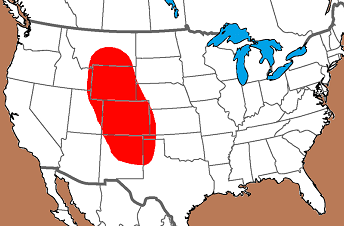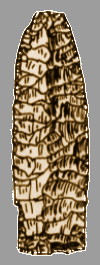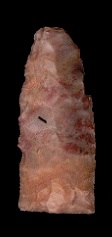Other Websites with Detailed Information:
Name Details:
Named By: Frank H. H. Roberts
Named For: Type Site
Date Identified: 1942
Type Site: San Jon site (LA 6437), Quay County, New Mexico
San Jon
(Discontinued Type)
Cluster:
Commonly Utilized Material:
Date:
Cultural Period:
9,500 - 8,000 B.P.
Transitional Paleo
Early Holocene
Glacial Period:
Culture:
Outline is Representative of Size and Shape:
Description of Physical Characteristics and Flaking Pattern:
This is a
thick medium
to large lanceolate point with a strong lenticular cross section
approaching a rounded median ridge. The blade is excurvate,
curving out at the tip and with parallel edges above the shoulders. The shoulders are weak to absent with a straight stem. The stem, when
present, is squared and formed by heavy grinding of the hafting region which forms a slight stemmed appearance. The base primarily straight with a slight indention and has a wedge
shape. The flaking pattern may vary from collateral to parallel and oblique flaking.
Measurements: Length - 45 to 61 mm,
Width - 17 to 20 mm
Distribution:
Distribution Comments:
This point is primarily has been reported at the San Jon site in Quay
County, New Mexico, the Claypool site in northeastern Colorado, The
Horner site in Park County, Wyoming, and the Finley site in Albany
County, Wyoming.

Similar Points:
Agate Basin, Angostura, Alberta, Eden, Firstview, Holland, Nebo Hill, Milnesand, Plainview, Red River, Scottsbluff Related / Associated Points:
Additional Comments:
Points originally found on the surface of the San Jon site and were named San Jon points. These points were re-typed as
Scottsbluff and Eden type points. Wormington (1952) argued that San Jon typology was inappropriate to used because all examples had
overlapping characteristics of Scottsbluff points and should be considered part of the Cody Complex.
Wheat (1972) argues that the smaller dimensions than usually seen on
Scottsbluff point, these would be most characteristic of a reworked Eden
point
Knudson (199) argues that Roberts did not intend on this being considered a valid unique type, but may have used this name only as a way to identify points that were found at this site.
Other points in this Cluster:
Point Validity: Discontinued Type
Roberts was an accomplished and influential archaeologist for the Smithsonian Institute who
greatly enhanced our understanding of the Paleo period cultures and American archaeology. This type was named in a professional publication, but has many overlapping characteristics with the Firstveiw type and
other points in the Cody Complex. It has been argued by many that this is not a valid type and should be discontinued. This is a discontinued type.
.
Age Details:
Radiocarbon dating of Area II bone bead associated with the San Jon points at the San Jon site provided dates of 8360 +/- 210 (Hill 1995).
Pictures Provided By:
Example from San Jon Site as Illustrated by Knudson, 1995
References: (See Reference Page, Entry Number):
30, 117
San Jon Projectile Point, San Jon Arrowhead





